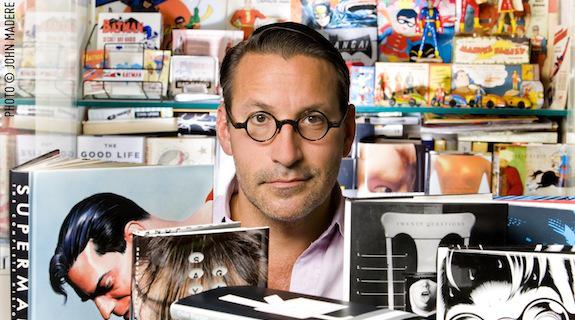In graphic design, there is one seemingly simple choice that can turn into an almost existential quandary: “How clear should something be and how mysterious should something be?”
Renowned book jacket designer Chip Kidd addressed that query at length on Wednesday, as part of his PromaxBDA: The Conference session “‘! or ?’: Chip Kidd and the Graphic Art of Clarity. Or Not.” Drawing primarily from his own body of work to illustrate the difference, the event was a pleasant journey through some of the great works of a groundbreaking artist.
“Mystery is a code,” Kidd told the crowd, “and when it’s done well it’s a code you want to crack.”
To that end, he supplied an image of nothing more than two dots bordered by what appeared to be parentheses, then baffled attendees by asking if they knew what it was. Pulling back, it became clear the symbols were part of the face of Charlie Brown, a trick that highlighted the sublimely simple design of Charles M. Schulz’s iconic comic strip character.
“Using only seven symbols, Schulz created an entire emotional life of a character out of almost nothing,” said Kidd.
A great admirer of Schulz, Kidd has a book-length homage to the cartoonist coming out in October, Only What’s Necessary: Charles M. Schulz and the Art of Peanuts. The cover will depict nothing more than Charlie Brown’s amazingly uncomplicated yet endlessly expressive mug.
In his own career, which has lead him to become associate art director at Alfred A. Knopf as well as an editor and designer of graphic novels for Pantheon, Kidd has constantly sought a similar balance, looking to “entice the reader and give them just enough info without giving them too much,” he said.” It’s a process he described as “the visual vernacular,” which involves “using the visual language of one thing to try and explain the other.”
For example, while working on the cover for David Rakoff’s essay collection Fraud, Kidd had to figure out how to visually portray a “skinny little urbanite unqualified to represent himself” in his hilarious accounts of white-water rafting and other activities he had no business doing. In the end, Kidd elected to use the visual vernacular of graffiti to get the point across, particularly what he called the “op/ed” variety, wherein the artist in question uses a Sharpie or other marker to make an editorial statement about the subject matter on a poster, billboard or other platform. The concept in Kidd’s mind was, “I buy this book by this guy and then I start reading it and I think, ‘he’s a fraud.’ And so I get angry and I take out a red magic marker and I scribble the title on the front.”

Kidd has worked on the books of many authors, but few with as much frequency as bestselling Japanese novelist Haruki Murakami, for whom he has designed for more than 20 years. Murakami’s dreamy, surreal style seems to mesh well with Kidd’s spare, striking designs. On the writer’s novel 1Q84, for instance (which he described as “a designer’s wet dream”), Kidd dealt with the story’s shifting time narrative by splitting the cover itself into two different dimensions that only work properly when paired together:

And on the atmospheric novel Colorless Tsukuru Tazaki and His Years of Pilgrimage, he interpreted the protagonist’s train fixation literally, turning the jacket into an abstraction of the complicated Tokyo subway system.
“You should be clear with very important information like, ‘How do I fix my computer?’” said Kidd. “But mystery is more fun and interesting and we should use it when we’re dealing with things that are more about entertainment.”
Image courtesy of Chip Kidd/Alfred A. Knopf.
Tags:













































__twocolumncontent.jpg)











